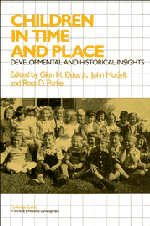Book contents
- Frontmatter
- Contents
- Preface
- Acknowledgments
- List of contributors
- Part I A proposal
- Part II Historical and life transitions
- 2 America's home front children in World War II
- 3 Rising above life's disadvantage: From the Great Depression to war
- 4 Child development and human diversity
- Part III Life transitions across historical time
- Part IV The cross-disciplinary collaboration
- Bibliography
- Author index
- Subject index
4 - Child development and human diversity
Published online by Cambridge University Press: 03 May 2011
- Frontmatter
- Contents
- Preface
- Acknowledgments
- List of contributors
- Part I A proposal
- Part II Historical and life transitions
- 2 America's home front children in World War II
- 3 Rising above life's disadvantage: From the Great Depression to war
- 4 Child development and human diversity
- Part III Life transitions across historical time
- Part IV The cross-disciplinary collaboration
- Bibliography
- Author index
- Subject index
Summary
Are American children becoming more different from each other?
Question posed at Belmont Conference (1987)Liberal capitalist theory in the nineteenth century raised individual achievement to a uniquely exalted position. An individual's achievement was understood as both the measure of his or her worth as a person and the measuring rod by which rewards might most efficiently be meted out (Halévy, 1928; Polanyi, 1957). The focus on the individual in this accounting contrasted sharply with the group or communal focus of precapitalist systems. Paralleling the spread of this ideology has been the development of increasingly clear-cut expectations for individual achievement at particular ages (Ariès, 1962; Gillis, 1974; Katz, 1975; Kett, 1977). Increasingly explicit lifetime schedules have been established for how much of what kind of work ought to be accomplished by particular ages.
Providing resources so that children can achieve appropriate goals has in many ways been defined as a public responsibility in the United States. Universal schooling has played a particularly important role in this mapping between age and achievement. Over time, public education has come to provide a formal schedule for which goals should be achieved by which ages and a means for measuring and marking the extent to which these goals were achieved. The public school system has been charged with simultaneously increasing mean performance (so that individuals will be more productive workers) and decreasing interindividual variance in performance (to maintain some degree of equality within the society) (Fishkin, 1983; Jencks, 1972; Levine & Bane, 1975; O'Neill, 1985; R. H. Turner, 1960).
- Type
- Chapter
- Information
- Children in Time and PlaceDevelopmental and Historical Insights, pp. 73 - 106Publisher: Cambridge University PressPrint publication year: 1993
- 3
- Cited by

